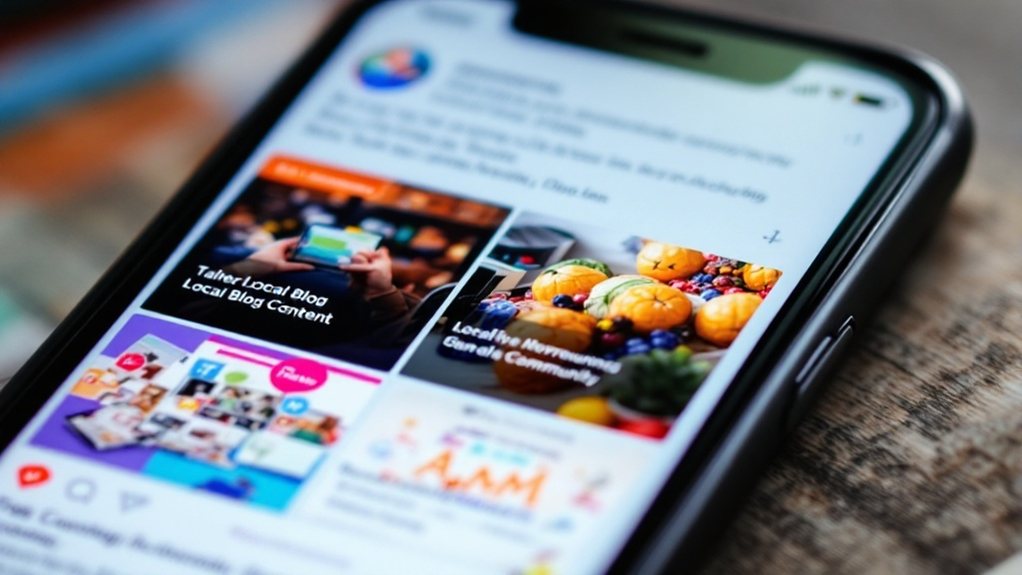To promote your local blog content on social media, first understand your audience by analyzing their demographics and preferences. Choose the right platforms that align with your goals, and localize your content to resonate with the community. Engage your local audience through interactive content and collaborations with relevant influencers. By leveraging data-driven insights, you can create an impactful social media strategy that drives real results for your local blog. Want to dive deeper into the details?
Understanding the Local Audience

When promoting local blog content on social media, it's crucial to first understand your local audience. Analyze demographic insights like age, gender, income levels, and education to tailor your content and marketing strategies. Recognize local preferences, interests, and behaviors to create targeted, engaging content. Leverage data sources like website analytics, social media insights, and customer surveys to gather these invaluable insights. With a deep understanding of your local audience, you can craft relevant, solution-oriented content that resonates and builds trust. This foundation will enable you to develop effective, localized marketing campaigns that differentiate your business and foster strong community engagement.
Choosing the Right Social Media Platforms

When promoting your local blog content, it's crucial to choose the right social media platforms that align with your audience's preferences. Start by mapping out your target demographic and their engagement styles across different platforms. This will help you select the most suitable channels to effectively reach and engage your local community. Facebook's large user base can be particularly effective for driving traffic to your local blog.
Platform Selection Criteria
Selecting the right social media platforms for your local blog content is crucial for maximizing its reach and engagement. Align your chosen platforms with your business goals, whether it's brand awareness, lead generation, or community engagement. Continuously track where the target audience is most active using analytics tools to guide your platform focus. Match your content's format – visual, textual, or interactive – with the strengths of each platform. Ensure you have the time and resources to maintain a consistent presence, and stay informed about platform updates that could enhance your engagement. Analyze your competitors' performance to set realistic goals, and adapt your strategy as the market and trends evolve. By strategically selecting your platforms, you'll effectively promote your local blog content.
Audience Preferences Mapping
Understanding your audience's preferences is the key to choosing the right social media platforms for promoting your local blog content. Analyze their:
- Content Formats: Some audiences prefer short-form videos on TikTok, while others enjoy long-form content on YouTube. Tailor your content to match their preferred formats. A social media target audience is a group of people on social that are most likely to be interested in a product or service.
- Tone and Style: Ensure your content's tone and style resonate with your audience's humor or seriousness. This could mean adopting a more casual approach on Instagram versus a more formal one on LinkedIn.
- Interactivity: Encourage audience engagement by incorporating interactive elements like Q&A sessions, which can boost your visibility and credibility.
Localizing Content for Maximum Impact

Ensuring your content resonates with local audiences is paramount for maximizing its impact. Develop detailed style guides covering branding, tone, and regional nuances. Tailor content formats to local preferences, from websites to social media. Optimize SEO with relevant keywords and references. Incorporate popular local hashtags, highlight community events, and customize messaging for regional interests. Leveraging localization tools like translation management systems, video subtitling, and image simplification can streamline the localization process. Prioritize legal compliance and consistent brand voice when localizing marketing content. Continuously monitor engagement metrics, analyze conversion rates, and refine your strategy based on audience feedback. Localizing content effectively can unlock new opportunities to connect with your target markets.
Engaging the Local Community
Engaging the local community on social media is essential for building brand awareness and fostering meaningful connections. By targeting the right audience, utilizing interactive content, and addressing local pain points, you can effectively engage your local community. Leveraging local social media marketing techniques can help businesses improve their local visibility, strengthen community connections, and enhance their brand reputation.
- Target the Right Audience: Conduct demographic analysis to identify your audience's age, location, interests, and preferred social platforms. This understanding will help you create relevant and engaging content that resonates with your local community.
- Utilize Interactive Content: Develop polls, Q&As, and behind-the-scenes content to boost engagement. Leverage live videos and interactive challenges to foster real-time interactions and build a stronger connection with your local audience.
- Address Local Pain Points: Identify specific challenges faced by your local audience and create content that provides solutions to these problems. Tailor your content to feel personally relevant and address the unique needs of your community.
Collaborating With Local Influencers
Teaming up with local influencers can drive remarkable results for promoting your blog content. Ensure the influencer's niche aligns with your blog to maximize relevance. Confirm their audience matches your target, and choose those with high engagement. Establish trust by engaging with their content, communicate clearly, and offer mutual benefits. Identify active platforms, develop a content strategy, and promote across channels. Encourage authentic storytelling, exclusive offers, and user-generated content. Local micro-influencers connect with followers and understand regional culture and trends. Track engagement, website traffic, SEO, and conversions to measure success. Leveraging local influencers can significantly amplify your blog's reach and credibility within the community.
Optimizing for Local Search and Visibility
Optimize your local blog content by including relevant geotags and location-specific hashtags. Local social signals influence search rank, as social media channels are viewed as valuable mentions of the business, enhancing the website's authority. Strategically incorporate target local keywords into your page titles, URLs, and headings to boost search visibility. Ensure your business listings are accurate and up-to-date across multiple platforms to further enhance local online presence.
Geotags and Hashtags
As businesses strive to enhance their local visibility and engagement, the strategic use of geotags and hashtags becomes a crucial component of their social media marketing efforts. By leveraging geotags, you can encourage user-generated content, reach new local audiences, and identify potential influencers for collaborations. Geotags provide insights into customer locations and foot traffic. Complementing geotags with relevant hashtags can further amplify your local reach and engagement, categorizing your content and aligning it with trending topics. Moreover, the combination of geotags and hashtags can establish your business as a local authority, while also allowing you to organize your content and measure the success of your campaigns through various analytics tools.
- Utilize geotags to encourage user-generated content and reach new local audiences.
- Pair geotags with relevant hashtags to enhance content visibility and engagement.
- Analyze the performance of your geotags and hashtags to refine your local social media strategy.
Local Keyword Optimization
Effective local keyword optimization is key to boosting your blog's visibility in area-specific searches. By leveraging the right local keywords, you can capture the attention of your target audience and outshine your competitors. Targeting local keywords can increase visibility and attract more organic traffic.
| Local Keyword Research | Local SEO Strategies | Optimizing Blog Posts |
|---|---|---|
| Use tools like Google Keyword Planner, Semrush, and Ahrefs to discover relevant local search terms. | Regularly update content, focus on hyperlocal topics, and target long-tail keywords. | Conduct thorough keyword research, ensure content relevance, and collaborate with local businesses. |
Integrate these local keywords seamlessly throughout your blog content, from titles and headings to internal links, to enhance your search engine rankings and attract more local customers.
Business Listings and Visibility
How can you leverage business listings and online visibility to drive local search success? Verified and complete Google Business Profiles are essential, as they can lead to 56% more website visits, 24% more calls, and 20% more branded searches. Furthermore, customers are 2.7 times more likely to view a business as reputable if it has a complete profile. To enhance your local visibility:
- Ensure your business information, including name, address, and phone number, is consistent across online directories and social media platforms.
- Optimize your Google Business Profile by providing detailed business details, high-quality images, and timely responses to reviews.
- Leverage "near me" searches by maintaining a strong local SEO strategy, including localized content and citations.
Creating a Localized Content Calendar
Why is creating a localized content calendar so crucial for promoting your local blog content on social media? Aligning your content with local events and trends enhances engagement with your target audience. Increasing the relevance of your content to specific geographic areas allows for precise geo-targeting, helping position your blog as a local authority. Use tools like Buffer, Canva, and Google Sheets to build your calendar, including key elements like posting dates, content formats, and relevant keywords. Schedule posts in advance for consistency, using analytics to determine optimal times. Involve your team in the planning process and establish clear roles and approval workflows to ensure your content strategy aligns with your business goals.
Responding to Reviews and Feedback
Responding to reviews and feedback on social media is crucial for maintaining your brand's reputation and fostering customer loyalty. Adopt an empathetic tone, address concerns promptly, and avoid placing blame. Offer solutions to resolve complaints and address both positive and negative feedback publicly to build credibility.
- Continuously monitor reviews and mentions across platforms, and integrate customer service to ensure consistency across all channels.
- Maintain a professional tone, and take complex issues offline to ensure detailed communication.
- Use customer reviews to gain insights and improve your products or services, and be transparent about addressing issues.
Participating in Local Events and Initiatives
Engaging with local events and initiatives can be a powerful way to build your blog's presence and connect with your community. Identify relevant local happenings that align with your niche, then create event-related content and use local hashtags to increase visibility. Partner with organizers to secure speaking opportunities or host workshops. Supporting local causes, sponsoring activities, and highlighting community achievements can demonstrate your social responsibility. Use event storytelling, generate buzz, and collaborate with influencers to reach a broader audience. Optimize content with location-specific keywords, publish event recaps, and leverage event-related keywords to drive traffic and engagement.
Leveraging Data-Driven Insights for Continuous Improvement
Continuously analyze your key performance metrics to assess what's working and what needs improvement. Use these data-driven insights to refine your content strategies and optimize your social media efforts for maximum impact. By iterating based on performance analytics, you can drive continuous improvement and better connect with your local audience.
Analyze Performance Metrics
Analyzing performance metrics is a crucial step in leveraging data-driven insights for continuous improvement of your local blog's content on social media. Focus on key engagement metrics like likes, comments, and shares to understand audience interaction. Additionally, track engagement rates using both per follower and per reach calculations to assess content effectiveness. Leverage social media analytics tools to gain insights into post performance and audience demographics. By identifying top-performing content types and optimizing for SEO, you can create more engaging and impactful social media content for your local audience.
- Utilize likes, comments, and shares to gauge audience engagement.
- Track engagement rates using per follower and per reach metrics.
- Leverage social media analytics tools to uncover audience insights.
Iterate Content Strategies
As you analyze the performance metrics of your local blog's social media content, you can leverage the insights gained to iteratively refine your content strategies. Continuously monitor audience preferences, experiment with different content formats, and adjust your strategies accordingly. A/B test content elements to determine what resonates best. Utilize social listening tools to understand audience sentiments and concerns, informing your content creation. Regularly review your content calendar and make data-driven decisions to ensure you're delivering the most relevant and engaging content. By adaptively responding to changing audience needs, you can maintain a continuous improvement loop that maximizes the impact of your local blog's social media presence.
